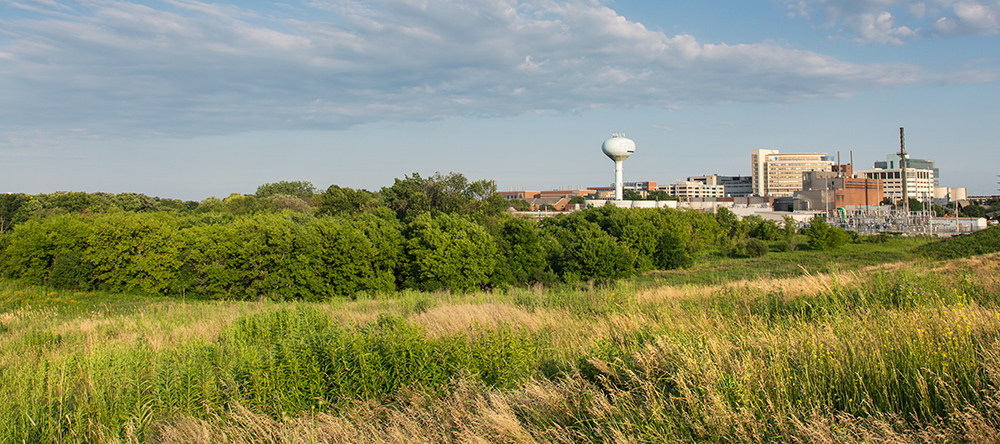
Wauwatosa citizens speak out (again): Save Sanctuary Woods!
December 5, 2018 | Topics: Issues
By Eddee Daniel and Jim Price
Although divided on the question of supporting or opposing a newly revised Master Plan, the will of the public was utterly clear on one point: Sanctuary Woods must be preserved.
The Wauwatosa Common Council held a public hearing last night to take comments regarding its proposed—and revised—Life Sciences District Master Plan. Members of the public spoke both in favor of and opposition to the plan. However, there was no disagreement that the ultimate goal is to save as much green space on the County Grounds as possible and to protect it in perpetuity.
In fact, you would have been hard pressed to detect any interest in the broader scope of the proposed Master Plan, which includes over 1,000 acres of the city. The county-owned parcels that make up what is commonly known as Sanctuary Woods—the focus of most of the attention—consist of just 66 acres out of the 235-acre Northeast Quadrant of the County Grounds.
It was a little hard to distinguish between those who spoke for and against the proposed plan, since every one of them made it clear that preserving the woods was the point. One of the primary objections cited by the large number of opponents was not a substantive critique of the plan, but rather the decision to put it forward at this time. Several pointed to the unanimous decision by the Wauwatosa Community Affairs Committee, made in May 2017, to shelve the plan until permanent protection of Sanctuary Woods was achieved—a stipulation that has not been met.
Others suggested that the new plan isn’t needed because the City of Wauwatosa already has a plan that they consider superior to it. That document, officially the Milwaukee County Grounds Master Plan and Design Guidelines, is popularly known as the Kubala-Washatko Plan for the architectural firm that created it. Although that plan is specific to the County Grounds and not inclusive of the whole LSD planning area, its balanced approach to sustainable development and environmental protection is seen by many as an effective model that the new plan could learn from.
Of the smaller number of plan supporters, the consensus was that while the current proposal is better than previous iterations it still needs tweaking to add better environmental protections. A series of specific ideas were presented by Barb Agnew, director of the Friends of the Monarch Trail on the County Grounds.
Freelance journalist and Wauwatosa resident Jim Price offered one of the most eloquent observations in a statement that does reference the larger vision for the City of Wauwatosa, which is printed here in its entirety:
“I am concerned that only vague language regarding building height and density, and lighting and noise, on several properties on the Northeast Quadrant, might undercut the very protections we all seek. In short, I worry that future development under this plan could still diminish the very thing we are all acting to save.
“I remind Council that it recently defeated, albeit narrowly, a proposal for a development of only four stories at the corner of Harwood and Harmonee on the edge of the Village. Why, when it had allowed two other developments of similar scale within the Village proper? Clearly, those two developments somehow fit our vision for Wauwatosa while the other did not. Why? Largely because of where it would have stood. It would have loomed over the quaint landscape of the Village in a way the others did not. It would have diminished a landscape that we hold dear.
“What I will call “the Wauwatosa Idea” has stood us well for over a hundred years: A potent business community surrounded by strong, cohesive neighborhoods of homes; great neighborhood schools; and beautiful parks and parkways. It is these values that have made Wauwatosa the magnet it is today. We now enter an era in which high-scale, high-value urban development has been deemed appropriate for certain areas, but let us not lose sight that other areas – residential neighborhoods and recreational corridors, for example – require more sensitivity.
“We hereby create a public commons, the County Grounds, that will be the envy of a thousand cities in years to come. Let us celebrate that commons without overwhelming it in a theme park atmosphere of light and noise and towering monuments to ourselves. Rather, let us tread lightly on its margins, mindful and respectful of why we acted to establish it.
“We have hereby determined not to steal the commons from the goose. Let us not then kill the goose that lays the golden egg.”
The council chambers were as packed as they have been all along for deliberations about the LSD Master Plan. However, while the public had a chance to speak, members of the Common Council itself did not. The public will have to return for another Common Council meeting on December 18 to find out what, if any, effect their testimony will have on the fate of the plan.
Related story at WUWM.

